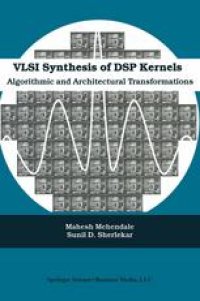
Ebook: VLSI Synthesis of DSP Kernels: Algorithmic and Architectural Transformations
- Tags: Circuits and Systems, Electrical Engineering, Computer-Aided Engineering (CAD CAE) and Design
- Year: 2001
- Publisher: Springer US
- Edition: 1
- Language: English
- pdf
A critical step in the design of a DSP system is to identify for each of its components (DSP kernels) an implementation architecture that provides the desired degree of flexibility/programmability and optimises the area-delay-power parameters. The book covers the entire solution space comprising both hardware multiplier-based and multiplex-less architectures that offer varying degrees of programmability. For each of the implementation styles, several algorithmic and architectural transformations are proposed so as to optimally implement weighted-sum based DSP kernels over the area-display-power space.
VLSI Synthesis of DSP Kernels presents the following:
- Programmable DSP-based implementation;
- Programmable processors with no dedicated hardware multiplier;
- Implementation using hardware multiplier(s) and adder(s);
- Distributed Arithmetic (DA)-based implementation;
- Residue Number System (RNS)-based implementation; and
- Multiplier-less implementation (using adders and shifters) for fixed coefficient DSP kernels.
A critical step in the design of a DSP system is to identify for each of its components (DSP kernels) an implementation architecture that provides the desired degree of flexibility/programmability and optimises the area-delay-power parameters. The book covers the entire solution space comprising both hardware multiplier-based and multiplex-less architectures that offer varying degrees of programmability. For each of the implementation styles, several algorithmic and architectural transformations are proposed so as to optimally implement weighted-sum based DSP kernels over the area-display-power space.
VLSI Synthesis of DSP Kernels presents the following:
- Programmable DSP-based implementation;
- Programmable processors with no dedicated hardware multiplier;
- Implementation using hardware multiplier(s) and adder(s);
- Distributed Arithmetic (DA)-based implementation;
- Residue Number System (RNS)-based implementation; and
- Multiplier-less implementation (using adders and shifters) for fixed coefficient DSP kernels.
A critical step in the design of a DSP system is to identify for each of its components (DSP kernels) an implementation architecture that provides the desired degree of flexibility/programmability and optimises the area-delay-power parameters. The book covers the entire solution space comprising both hardware multiplier-based and multiplex-less architectures that offer varying degrees of programmability. For each of the implementation styles, several algorithmic and architectural transformations are proposed so as to optimally implement weighted-sum based DSP kernels over the area-display-power space.
VLSI Synthesis of DSP Kernels presents the following:
- Programmable DSP-based implementation;
- Programmable processors with no dedicated hardware multiplier;
- Implementation using hardware multiplier(s) and adder(s);
- Distributed Arithmetic (DA)-based implementation;
- Residue Number System (RNS)-based implementation; and
- Multiplier-less implementation (using adders and shifters) for fixed coefficient DSP kernels.
Content:
Front Matter....Pages i-xxiii
Introduction....Pages 1-9
Programmable DSP Based Implementation....Pages 11-53
Implementation Using Hardware Multiplier(s) and Adder(s)....Pages 55-73
Distributed Arithmetic Based Implementation....Pages 75-111
Multiplier-Less Implementation....Pages 113-140
Implementation of Multiplication-Free Linear Transforms on a Programmable Processor....Pages 141-169
Residue Number System Based Implementation....Pages 171-185
A Framework for Algorithmic and Architectural Transformations....Pages 187-193
Summary....Pages 195-197
Back Matter....Pages 199-209
A critical step in the design of a DSP system is to identify for each of its components (DSP kernels) an implementation architecture that provides the desired degree of flexibility/programmability and optimises the area-delay-power parameters. The book covers the entire solution space comprising both hardware multiplier-based and multiplex-less architectures that offer varying degrees of programmability. For each of the implementation styles, several algorithmic and architectural transformations are proposed so as to optimally implement weighted-sum based DSP kernels over the area-display-power space.
VLSI Synthesis of DSP Kernels presents the following:
- Programmable DSP-based implementation;
- Programmable processors with no dedicated hardware multiplier;
- Implementation using hardware multiplier(s) and adder(s);
- Distributed Arithmetic (DA)-based implementation;
- Residue Number System (RNS)-based implementation; and
- Multiplier-less implementation (using adders and shifters) for fixed coefficient DSP kernels.
Content:
Front Matter....Pages i-xxiii
Introduction....Pages 1-9
Programmable DSP Based Implementation....Pages 11-53
Implementation Using Hardware Multiplier(s) and Adder(s)....Pages 55-73
Distributed Arithmetic Based Implementation....Pages 75-111
Multiplier-Less Implementation....Pages 113-140
Implementation of Multiplication-Free Linear Transforms on a Programmable Processor....Pages 141-169
Residue Number System Based Implementation....Pages 171-185
A Framework for Algorithmic and Architectural Transformations....Pages 187-193
Summary....Pages 195-197
Back Matter....Pages 199-209
....
Download the book VLSI Synthesis of DSP Kernels: Algorithmic and Architectural Transformations for free or read online
Continue reading on any device:

Last viewed books
Related books
{related-news}
Comments (0)